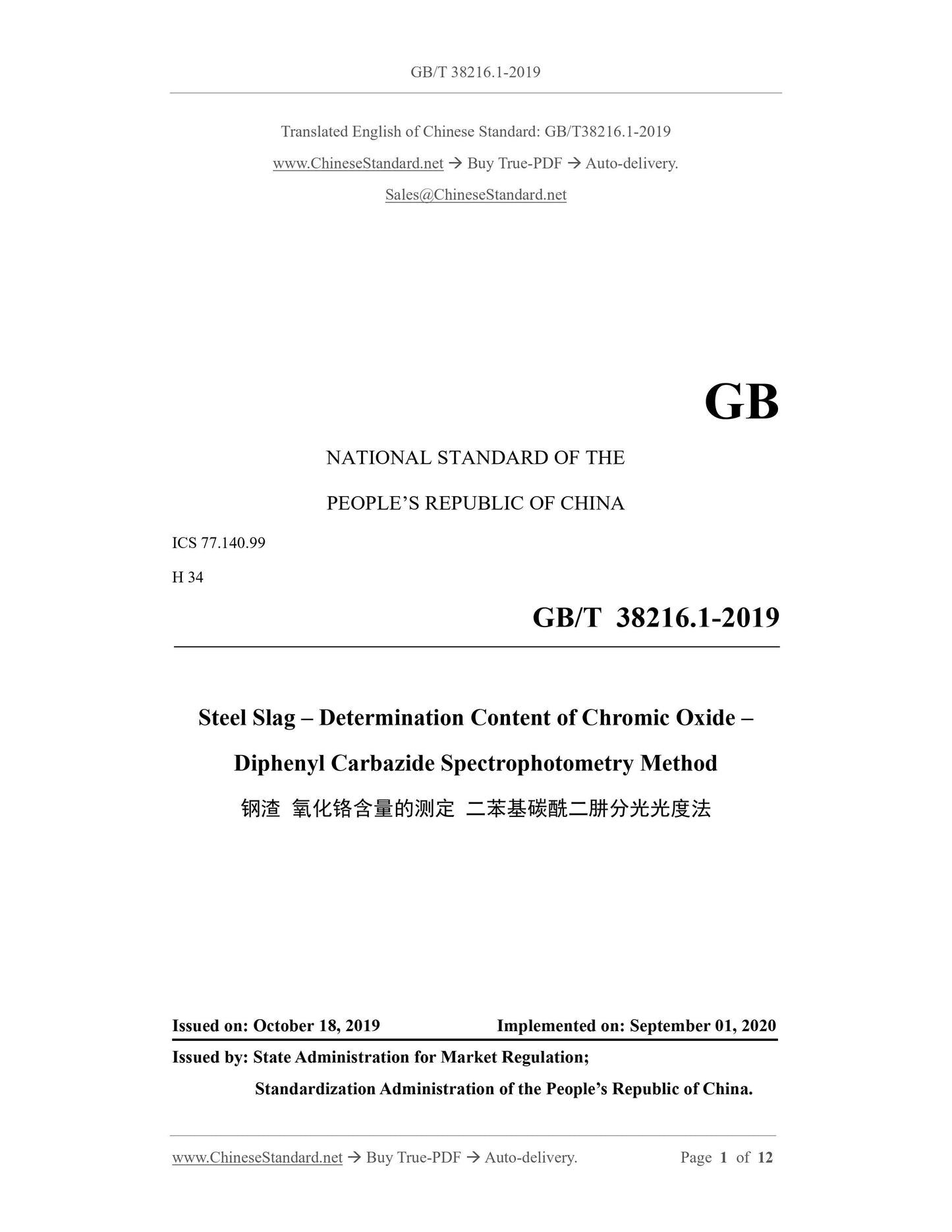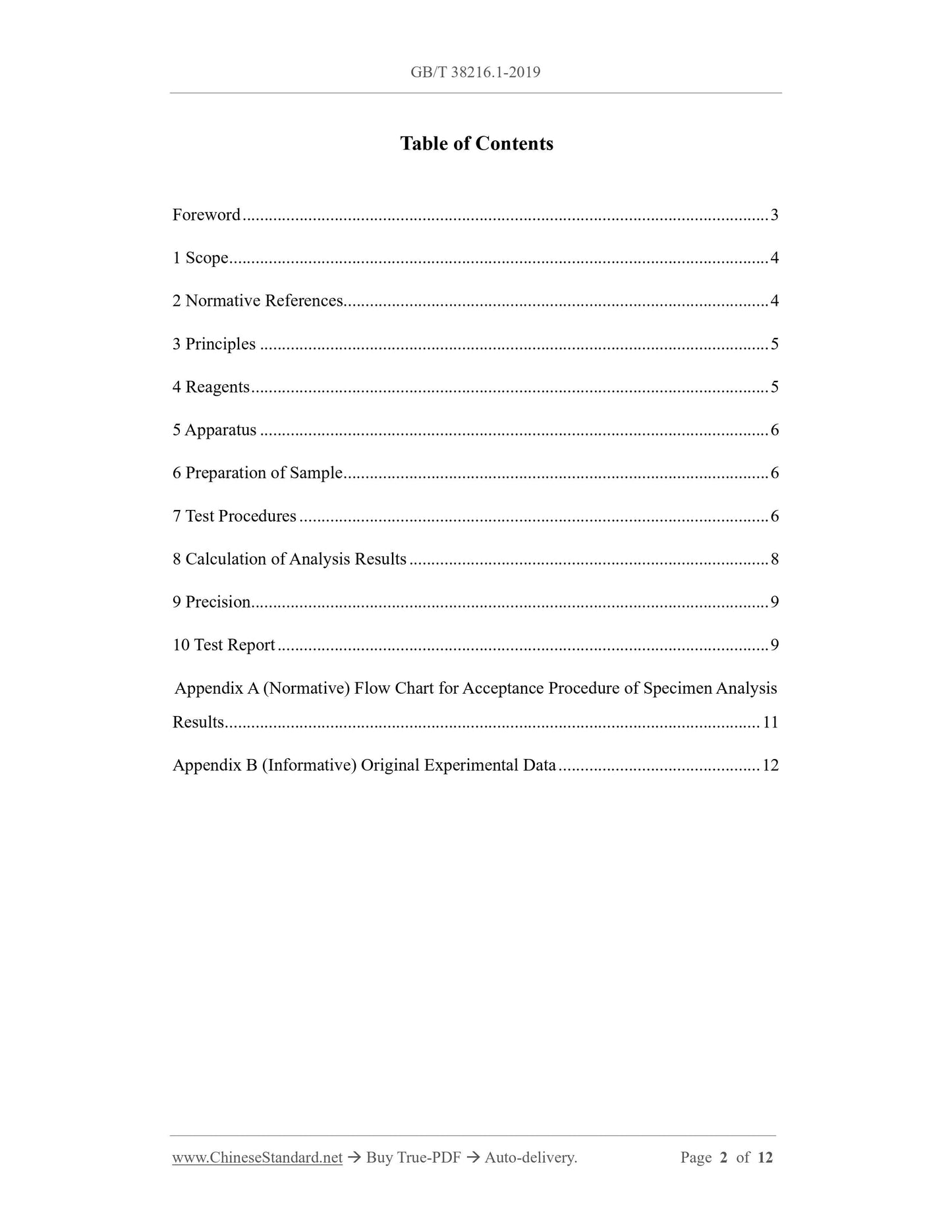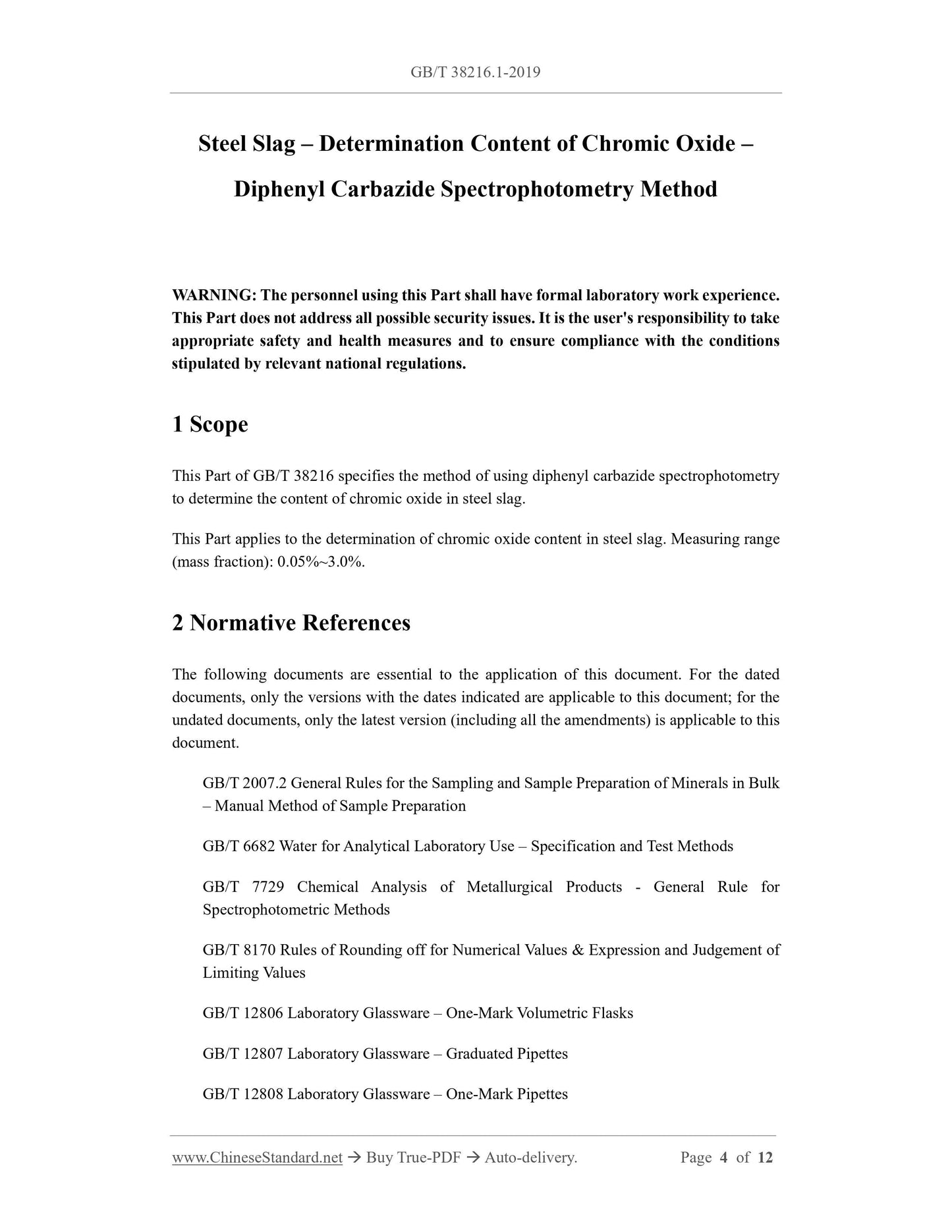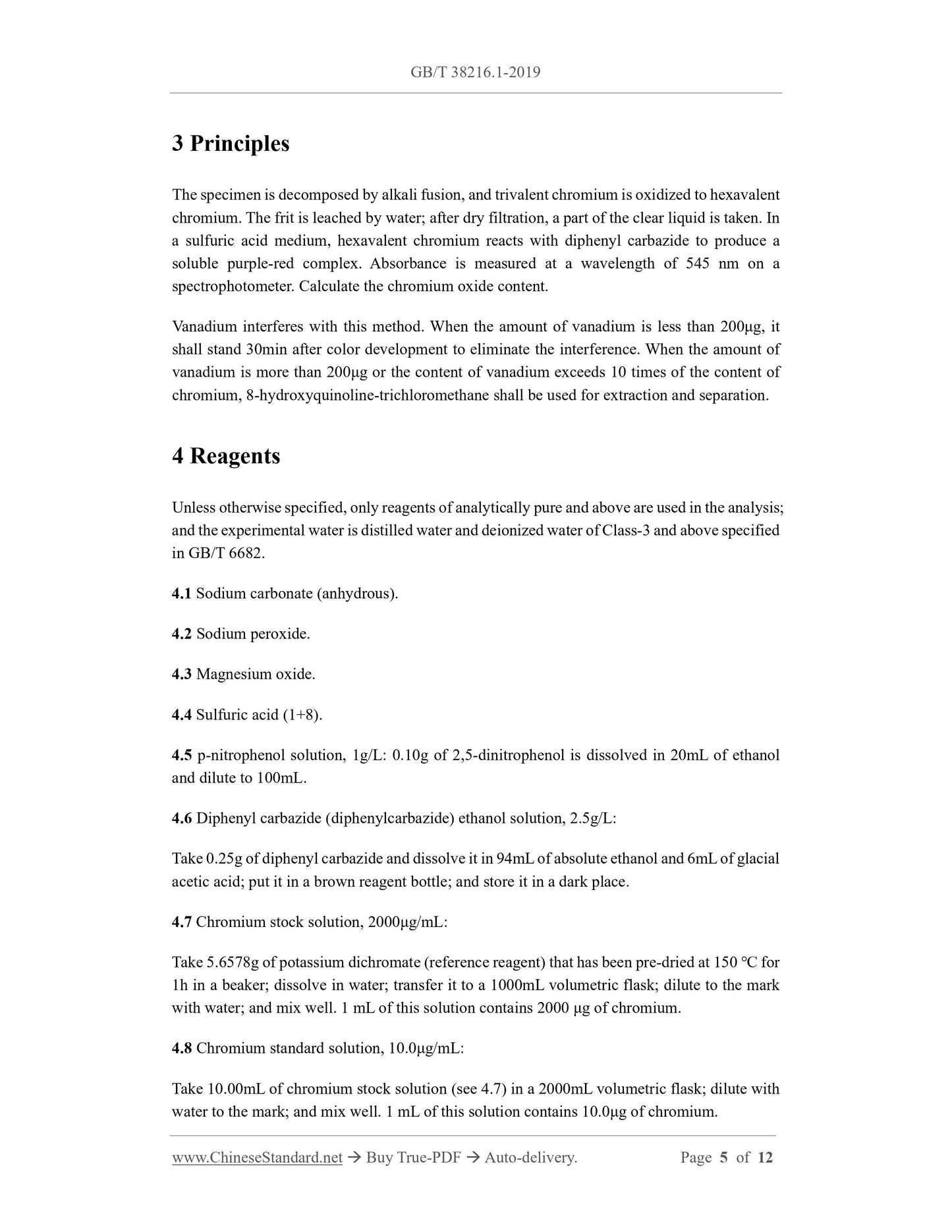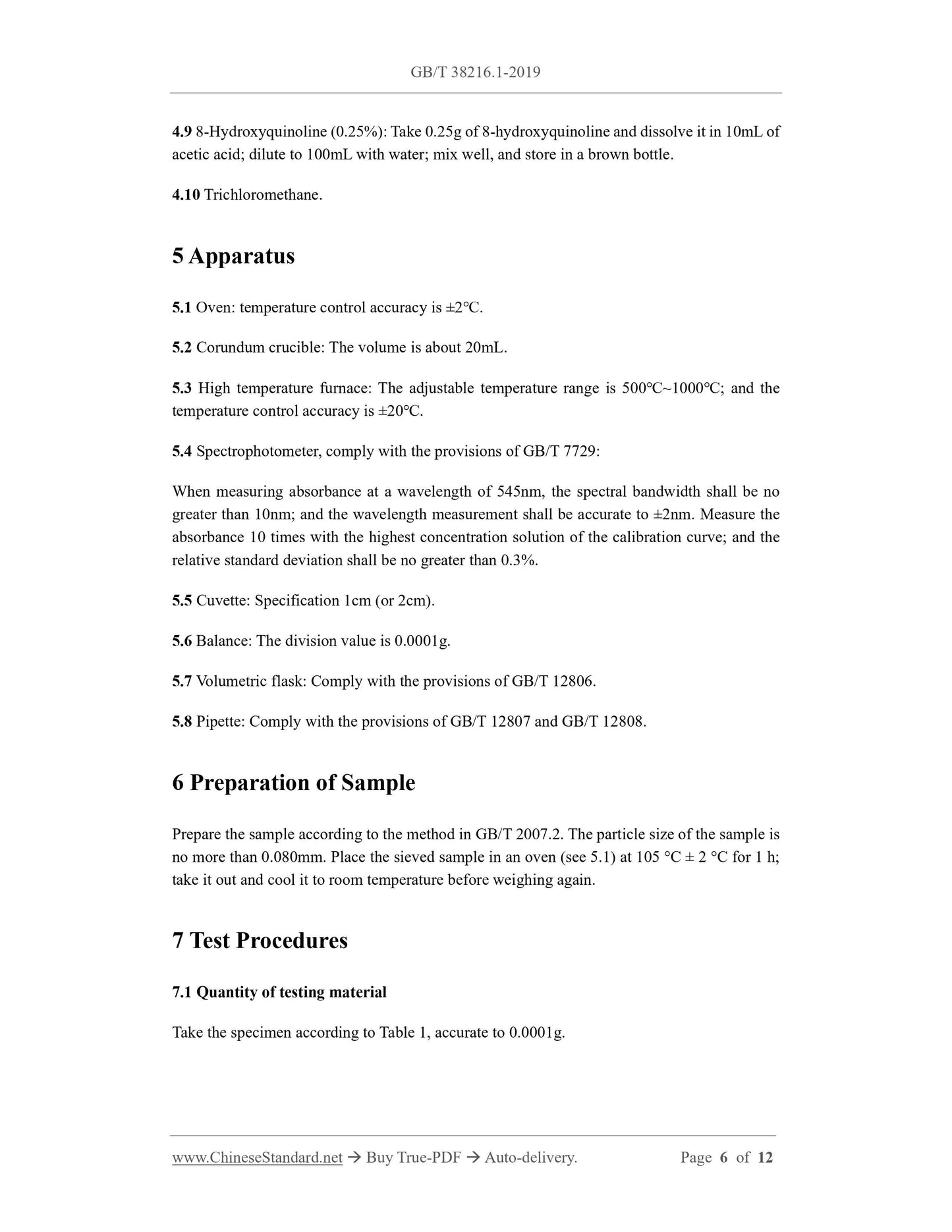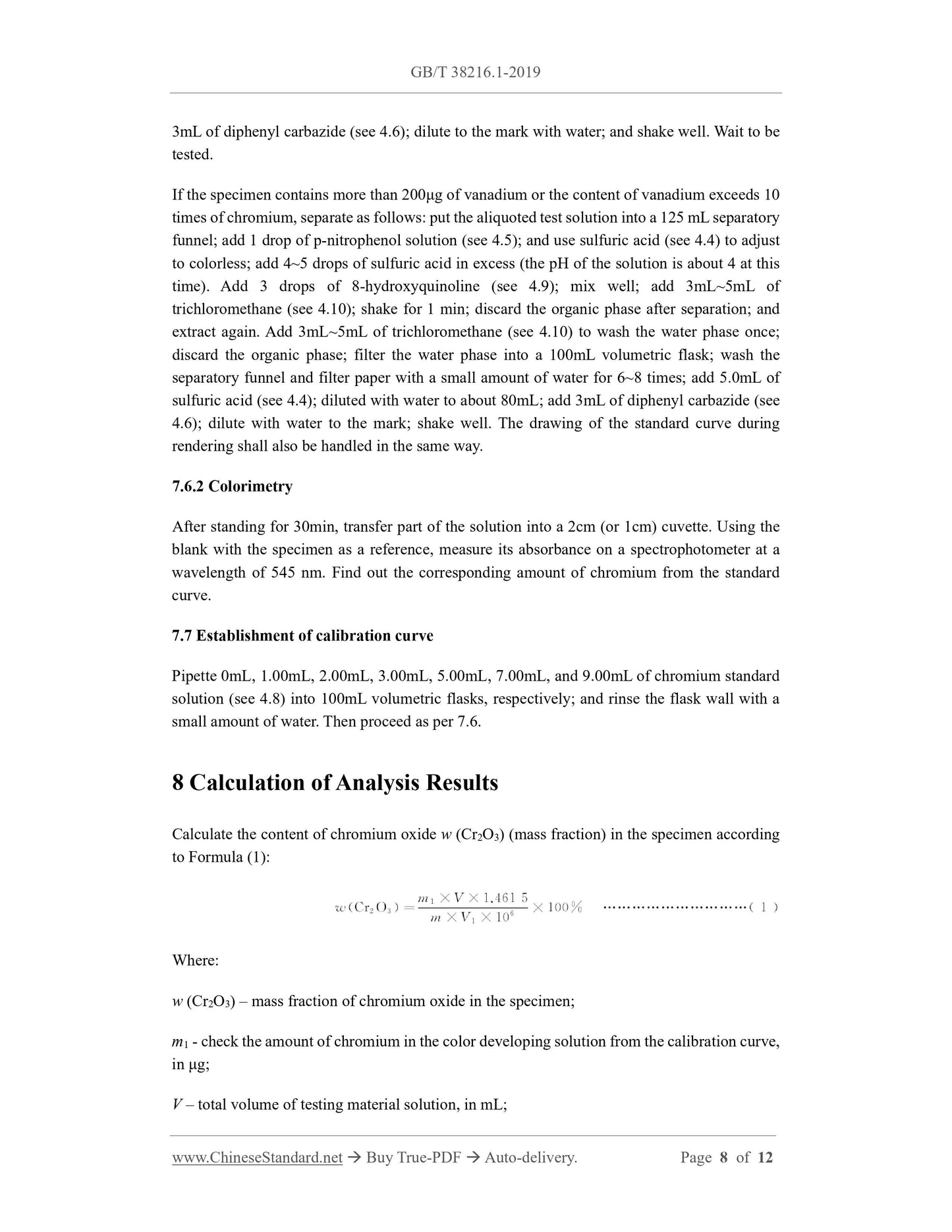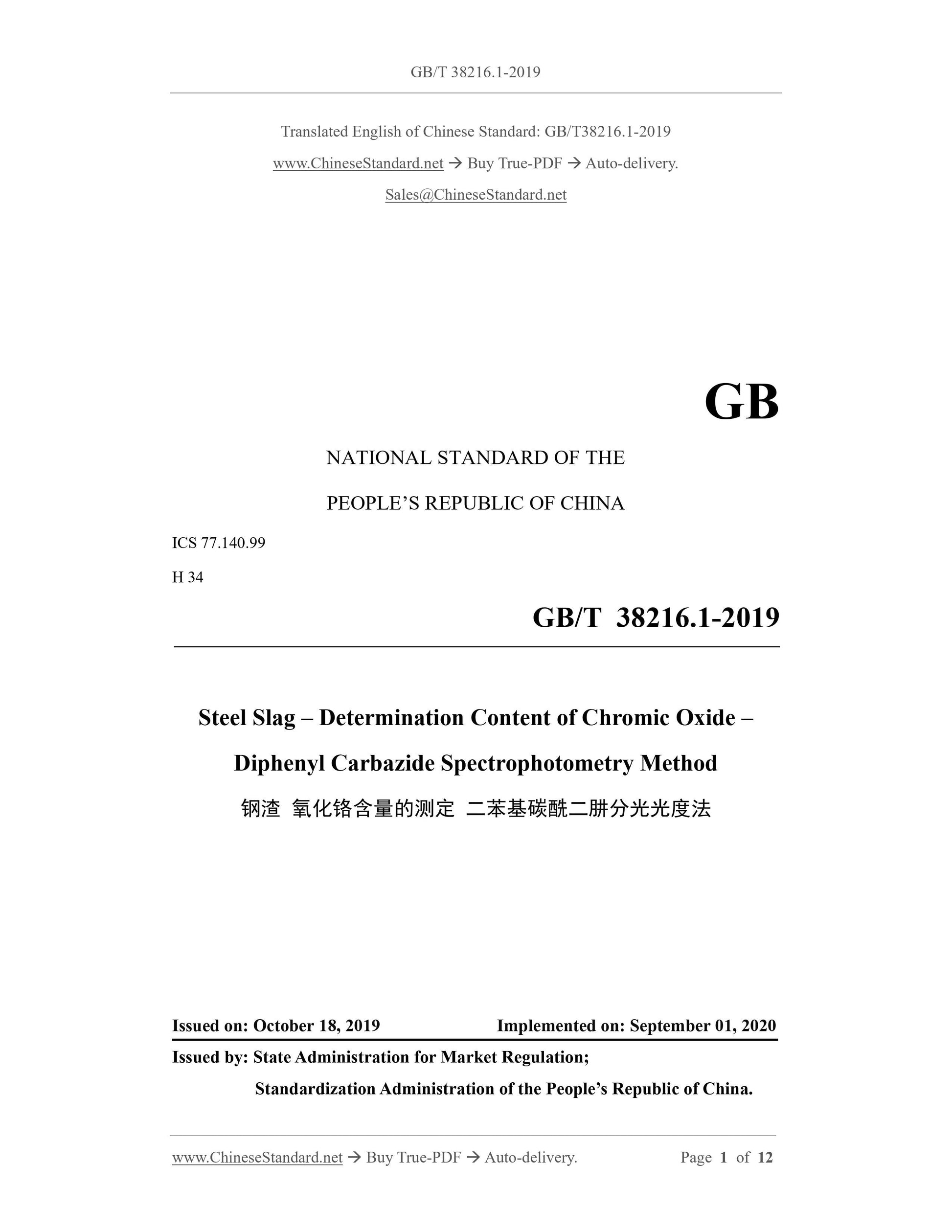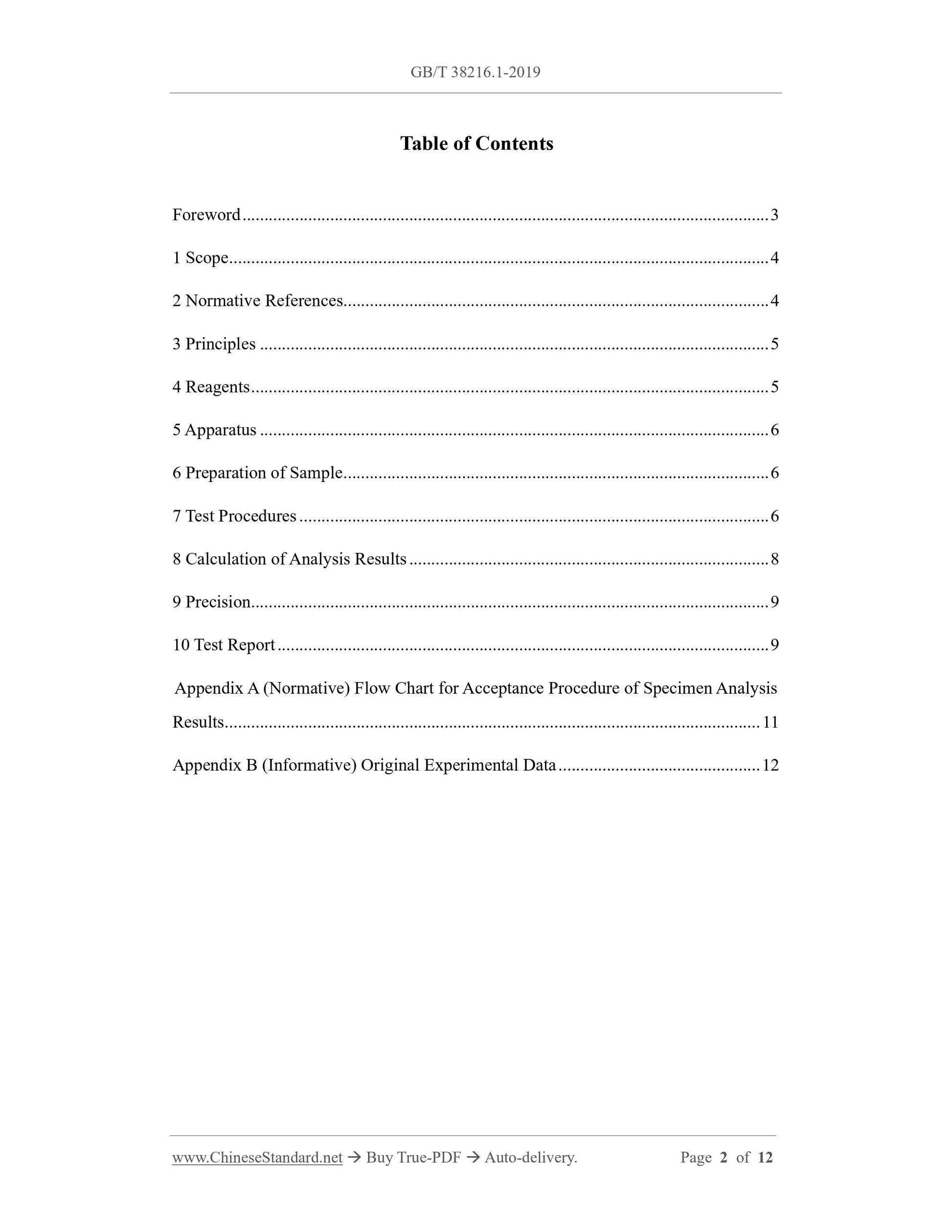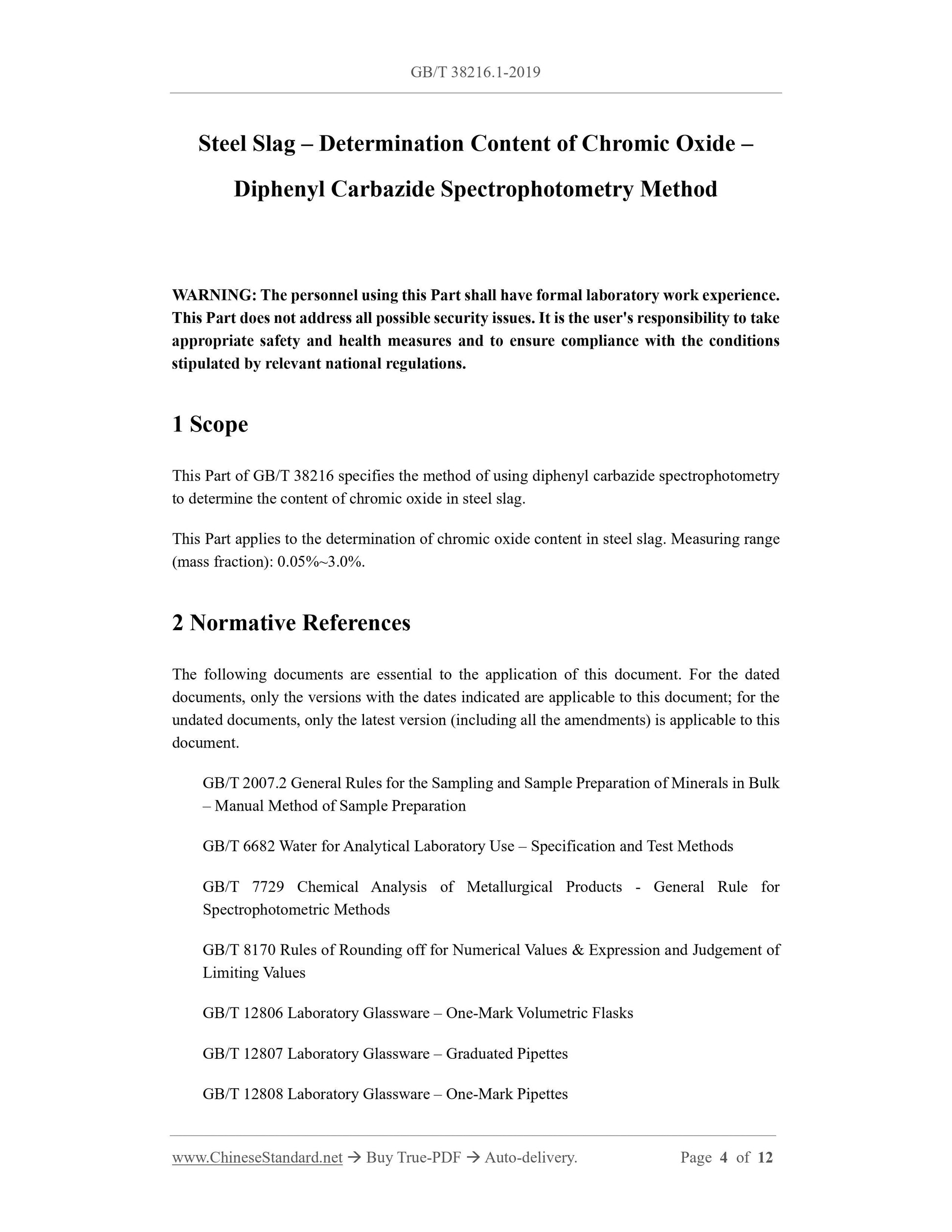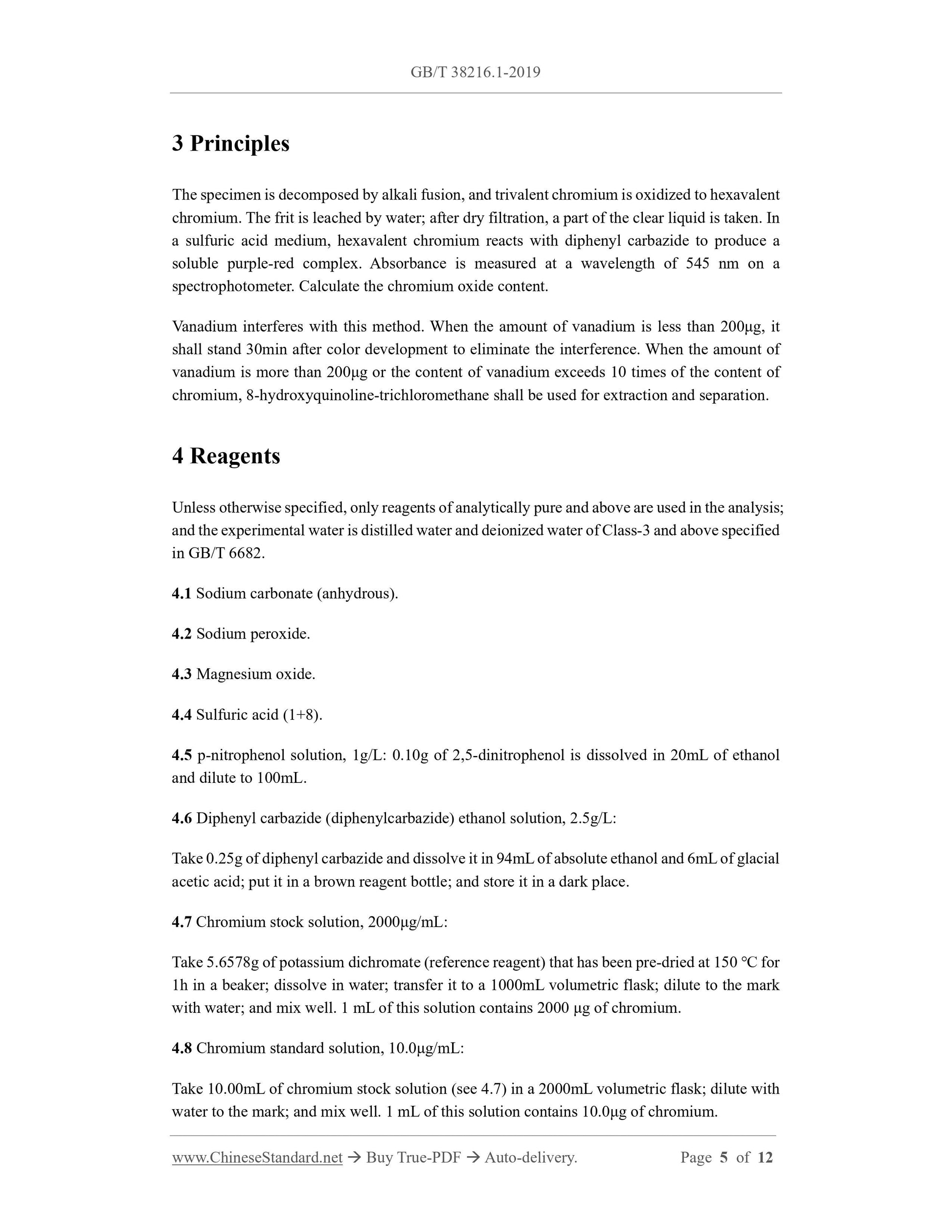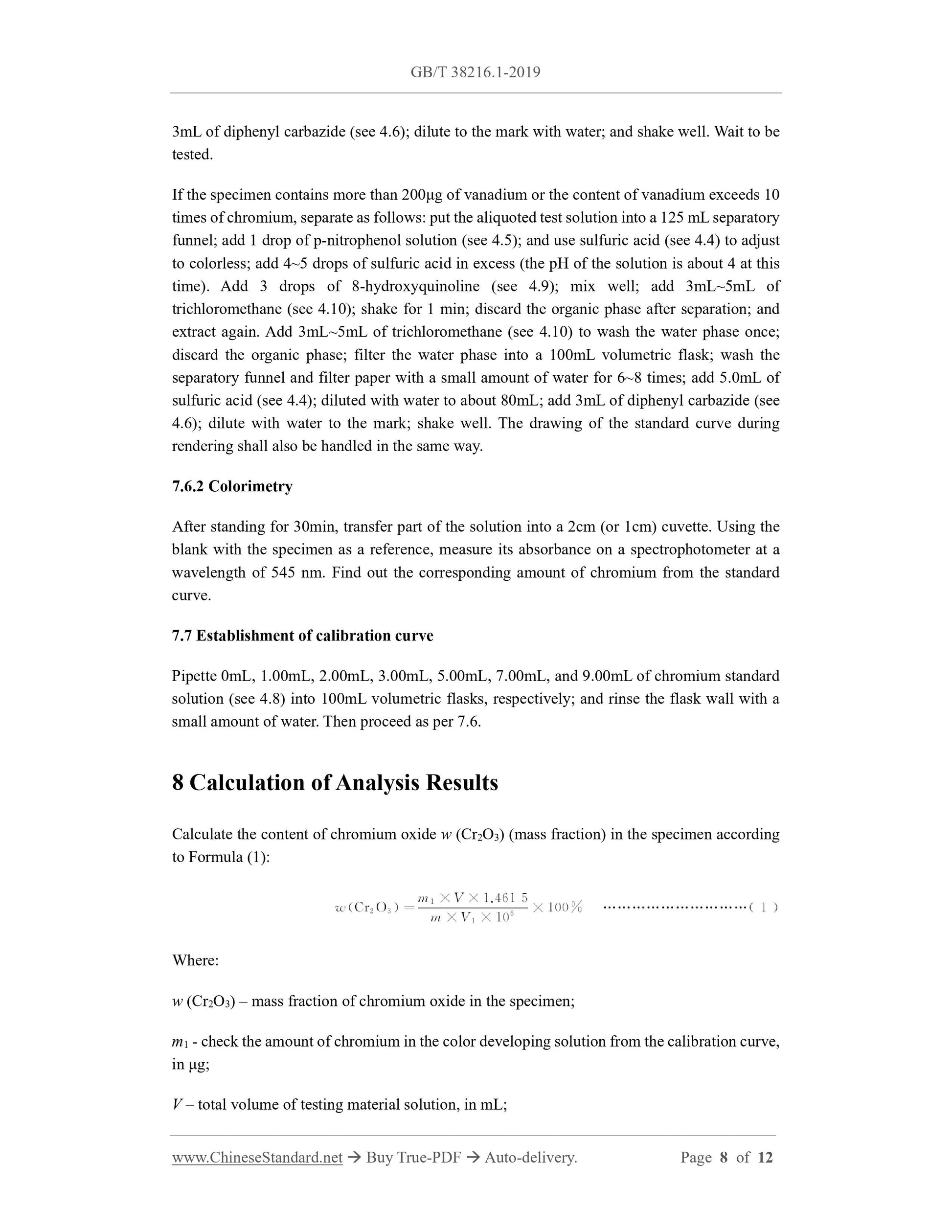1
/
of
6
PayPal, credit cards. Download editable-PDF & invoice in 1 second!
GB/T 38216.1-2019 English PDF (GBT38216.1-2019)
GB/T 38216.1-2019 English PDF (GBT38216.1-2019)
Regular price
$170.00 USD
Regular price
Sale price
$170.00 USD
Unit price
/
per
Shipping calculated at checkout.
Couldn't load pickup availability
Delivery: 3 seconds. Download true-PDF + Invoice.
Get QUOTATION in 1-minute: Click GB/T 38216.1-2019
Historical versions: GB/T 38216.1-2019
Preview True-PDF (Reload/Scroll if blank)
GB/T 38216.1-2019: Steel slag -- Determination content of chromic oxide -- Diphenyl carbazide spectrophotometry method
GB/T 38216.1-2019
GB
NATIONAL STANDARD OF THE
PEOPLE’S REPUBLIC OF CHINA
ICS 77.140.99
H 34
Steel Slag – Determination Content of Chromic Oxide –
Diphenyl Carbazide Spectrophotometry Method
ISSUED ON: OCTOBER 18, 2019
IMPLEMENTED ON: SEPTEMBER 01, 2020
Issued by: State Administration for Market Regulation;
Standardization Administration of the People’s Republic of China.
Table of Contents
Foreword ... 3
1 Scope ... 4
2 Normative References ... 4
3 Principles ... 5
4 Reagents ... 5
5 Apparatus ... 6
6 Preparation of Sample ... 6
7 Test Procedures ... 6
8 Calculation of Analysis Results ... 8
9 Precision ... 9
10 Test Report ... 9
Appendix A (Normative) Flow Chart for Acceptance Procedure of Specimen Analysis
Results ... 11
Appendix B (Informative) Original Experimental Data ... 12
Steel Slag – Determination Content of Chromic Oxide –
Diphenyl Carbazide Spectrophotometry Method
WARNING: The personnel using this Part shall have formal laboratory work experience.
This Part does not address all possible security issues. It is the user's responsibility to take
appropriate safety and health measures and to ensure compliance with the conditions
stipulated by relevant national regulations.
1 Scope
This Part of GB/T 38216 specifies the method of using diphenyl carbazide spectrophotometry
to determine the content of chromic oxide in steel slag.
This Part applies to the determination of chromic oxide content in steel slag. Measuring range
(mass fraction): 0.05%~3.0%.
2 Normative References
The following documents are essential to the application of this document. For the dated
documents, only the versions with the dates indicated are applicable to this document; for the
undated documents, only the latest version (including all the amendments) is applicable to this
document.
GB/T 2007.2 General Rules for the Sampling and Sample Preparation of Minerals in Bulk
– Manual Method of Sample Preparation
GB/T 6682 Water for Analytical Laboratory Use – Specification and Test Methods
GB/T 7729 Chemical Analysis of Metallurgical Products - General Rule for
Spectrophotometric Methods
GB/T 8170 Rules of Rounding off for Numerical Values and Expression and Judgement of
Limiting Values
GB/T 12806 Laboratory Glassware – One-Mark Volumetric Flasks
GB/T 12807 Laboratory Glassware – Graduated Pipettes
GB/T 12808 Laboratory Glassware – One-Mark Pipettes
3 Principles
The specimen is decomposed by alkali fusion, and trivalent chromium is oxidized to hexavalent
chromium. The frit is leached by water; after dry filtration, a part of the clear liquid is taken. In
a sulfuric acid medium, hexavalent chromium reacts with diphenyl carbazide to produce a
soluble purple-red complex. Absorbance is measured at a wavelength of 545 nm on a
spectrophotometer. Calculate the chromium oxide content.
Vanadium interferes with this method. When the amount of vanadium is less than 200μg, it
shall stand 30min after color development to eliminate the interference. When the amount of
vanadium is more than 200μg or the content of vanadium exceeds 10 times of the content of
chromium, 8-hydroxyquinoline-trichloromethane shall be used for extraction and separation.
4 Reagents
Unless otherwise specified, only reagents of analytically pure and above are used in the analysis;
and the experimental water is distilled water and deionized water of Class-3 and above specified
in GB/T 6682.
4.1 Sodium carbonate (anhydrous).
4.2 Sodium peroxide.
4.3 Magnesium oxide.
4.4 Sulfuric acid (1+8).
4.5 p-nitrophenol solution, 1g/L: 0.10g of 2,5-dinitrophenol is dissolved in 20mL of ethanol
and dilute to 100mL.
4.6 Diphenyl carbazide (diphenylcarbazide) ethanol solution, 2.5g/L:
Take 0.25g of diphenyl carbazide and dissolve it in 94mL of absolute ethanol and 6mL of glacial
acetic acid; put it in a brown reagent bottle; and store it in a dark place.
4.7 Chromium stock solution, 2000μg/mL:
Take 5.6578g of potassium dichromate (reference reagent) that has been pre-dried at 150 ℃ for
1h in a beaker; dissolve in water; transfer it to a 1000mL volumetric flask; dilute to the mark
with water; and mix well. 1 mL of this solution contains 2000 μg of chromium.
4.8 Chromium standard solution, 10.0μg/mL:
Take 10.00mL of chromium stock solution (see 4.7) in a 2000mL volumetric flask; dilute with
water to the mark; and mix well. 1 mL of this solution contains 10.0μg of chromium.
4.9 8-Hydroxyquinoline (0.25%): Take 0.25g of 8-hydroxyquinoline and dissolve it in 10mL of
acetic acid; dilute to 100mL with water; mix well, and store in a brown bottle.
4.10 Trichloromethane.
5 Apparatus
5.1 Oven: temperature control accuracy is ±2℃.
5.2 Corundum crucible: The volume is about 20mL.
5.3 High temperature furnace: The adjustable temperature range is 500℃~1000℃; and the
temperature control accuracy is ±20℃.
5.4 Spectrophotometer, comply with the provisions of GB/T 7729:
When measuring absorbance at a wavelength of 545nm, the spectral bandwidth shall be no
greater than 10nm; and the wavelength measurement shall be accurate to ±2nm. Measure the
absorbance 10 times with the highest concentration solution of the calibration curve; and the
relative standard deviation shall be no greater than 0.3%.
5.5 Cuvette: Specification 1cm (or 2cm).
5.6 Balance: The division value is 0.0001g.
5.7 Volumetric flask: Comply with the provisions of GB/T 12806.
5.8 Pipette: Comply with the provisions of GB/T 12807 and GB/T 12808.
6 Preparation of Sample
Prepare the sample according to the method in GB/T 2007.2. The particle size of the sample is
no more than 0.080mm. Place the sieved sample in an oven (see 5.1) at 105 °C ± 2 °C for 1 h;
take it out and cool it to room temperature before weighing again.
7 Test Procedures
7.1 Quantity of testing material
Take the specimen according to Table 1, accurate to 0.0001g.
3mL of diphenyl carbazide (see 4.6); dilute to the mark with water; and shake well. Wait to be
tested.
If the specimen contains more than 200μg of vanadium or the content of vanadium exceeds 10
times of chromium, separate as follows: put the aliquoted test solution into a 125 mL separatory
funnel; add 1 drop of p-nitrophenol solution (see 4.5); and use sulfuric acid (see 4.4) to adjust
to colorless; add 4~5 drops of sulfuric acid in excess (the pH of the solution is about 4 at this
time). Add 3 drops of 8-hydroxyquinoline (see 4.9); mix well; add 3mL~5mL of
trichloromethane (see 4.10); shake for 1 min; discard the organic phase after separation; and
extract again. Add 3mL~5mL of trichloromethane (see 4.10) to wash the water phase once;
discard the organic phase; filter the water phase into a 100mL volumetric flask; wash the
separatory funnel and filter paper with a small amount of water for 6~8 times; add 5.0mL of
sulfuric acid (see 4.4); diluted with water to about 80mL; add 3mL of diphenyl carbazide (see
4.6); dilute with water to the mark; shake well. The drawing of the standard curve during
rendering shall also be handled in the same way.
7.6.2 Colorimetry
After standing for 30min, transfer part of the solution into a 2cm (or 1cm) cuvette. Using the
blank with the specimen as a reference, measure its absorbance on a spectrophotometer at a
wavelength of 545 nm. Find out the corresponding amount of chromium from the standard
curve.
7.7 Establishment of calibration curve
Pipette 0mL, 1.00mL, 2.00mL, 3.00mL, 5.00mL, 7.00mL, and 9.00mL of chromium...
Get QUOTATION in 1-minute: Click GB/T 38216.1-2019
Historical versions: GB/T 38216.1-2019
Preview True-PDF (Reload/Scroll if blank)
GB/T 38216.1-2019: Steel slag -- Determination content of chromic oxide -- Diphenyl carbazide spectrophotometry method
GB/T 38216.1-2019
GB
NATIONAL STANDARD OF THE
PEOPLE’S REPUBLIC OF CHINA
ICS 77.140.99
H 34
Steel Slag – Determination Content of Chromic Oxide –
Diphenyl Carbazide Spectrophotometry Method
ISSUED ON: OCTOBER 18, 2019
IMPLEMENTED ON: SEPTEMBER 01, 2020
Issued by: State Administration for Market Regulation;
Standardization Administration of the People’s Republic of China.
Table of Contents
Foreword ... 3
1 Scope ... 4
2 Normative References ... 4
3 Principles ... 5
4 Reagents ... 5
5 Apparatus ... 6
6 Preparation of Sample ... 6
7 Test Procedures ... 6
8 Calculation of Analysis Results ... 8
9 Precision ... 9
10 Test Report ... 9
Appendix A (Normative) Flow Chart for Acceptance Procedure of Specimen Analysis
Results ... 11
Appendix B (Informative) Original Experimental Data ... 12
Steel Slag – Determination Content of Chromic Oxide –
Diphenyl Carbazide Spectrophotometry Method
WARNING: The personnel using this Part shall have formal laboratory work experience.
This Part does not address all possible security issues. It is the user's responsibility to take
appropriate safety and health measures and to ensure compliance with the conditions
stipulated by relevant national regulations.
1 Scope
This Part of GB/T 38216 specifies the method of using diphenyl carbazide spectrophotometry
to determine the content of chromic oxide in steel slag.
This Part applies to the determination of chromic oxide content in steel slag. Measuring range
(mass fraction): 0.05%~3.0%.
2 Normative References
The following documents are essential to the application of this document. For the dated
documents, only the versions with the dates indicated are applicable to this document; for the
undated documents, only the latest version (including all the amendments) is applicable to this
document.
GB/T 2007.2 General Rules for the Sampling and Sample Preparation of Minerals in Bulk
– Manual Method of Sample Preparation
GB/T 6682 Water for Analytical Laboratory Use – Specification and Test Methods
GB/T 7729 Chemical Analysis of Metallurgical Products - General Rule for
Spectrophotometric Methods
GB/T 8170 Rules of Rounding off for Numerical Values and Expression and Judgement of
Limiting Values
GB/T 12806 Laboratory Glassware – One-Mark Volumetric Flasks
GB/T 12807 Laboratory Glassware – Graduated Pipettes
GB/T 12808 Laboratory Glassware – One-Mark Pipettes
3 Principles
The specimen is decomposed by alkali fusion, and trivalent chromium is oxidized to hexavalent
chromium. The frit is leached by water; after dry filtration, a part of the clear liquid is taken. In
a sulfuric acid medium, hexavalent chromium reacts with diphenyl carbazide to produce a
soluble purple-red complex. Absorbance is measured at a wavelength of 545 nm on a
spectrophotometer. Calculate the chromium oxide content.
Vanadium interferes with this method. When the amount of vanadium is less than 200μg, it
shall stand 30min after color development to eliminate the interference. When the amount of
vanadium is more than 200μg or the content of vanadium exceeds 10 times of the content of
chromium, 8-hydroxyquinoline-trichloromethane shall be used for extraction and separation.
4 Reagents
Unless otherwise specified, only reagents of analytically pure and above are used in the analysis;
and the experimental water is distilled water and deionized water of Class-3 and above specified
in GB/T 6682.
4.1 Sodium carbonate (anhydrous).
4.2 Sodium peroxide.
4.3 Magnesium oxide.
4.4 Sulfuric acid (1+8).
4.5 p-nitrophenol solution, 1g/L: 0.10g of 2,5-dinitrophenol is dissolved in 20mL of ethanol
and dilute to 100mL.
4.6 Diphenyl carbazide (diphenylcarbazide) ethanol solution, 2.5g/L:
Take 0.25g of diphenyl carbazide and dissolve it in 94mL of absolute ethanol and 6mL of glacial
acetic acid; put it in a brown reagent bottle; and store it in a dark place.
4.7 Chromium stock solution, 2000μg/mL:
Take 5.6578g of potassium dichromate (reference reagent) that has been pre-dried at 150 ℃ for
1h in a beaker; dissolve in water; transfer it to a 1000mL volumetric flask; dilute to the mark
with water; and mix well. 1 mL of this solution contains 2000 μg of chromium.
4.8 Chromium standard solution, 10.0μg/mL:
Take 10.00mL of chromium stock solution (see 4.7) in a 2000mL volumetric flask; dilute with
water to the mark; and mix well. 1 mL of this solution contains 10.0μg of chromium.
4.9 8-Hydroxyquinoline (0.25%): Take 0.25g of 8-hydroxyquinoline and dissolve it in 10mL of
acetic acid; dilute to 100mL with water; mix well, and store in a brown bottle.
4.10 Trichloromethane.
5 Apparatus
5.1 Oven: temperature control accuracy is ±2℃.
5.2 Corundum crucible: The volume is about 20mL.
5.3 High temperature furnace: The adjustable temperature range is 500℃~1000℃; and the
temperature control accuracy is ±20℃.
5.4 Spectrophotometer, comply with the provisions of GB/T 7729:
When measuring absorbance at a wavelength of 545nm, the spectral bandwidth shall be no
greater than 10nm; and the wavelength measurement shall be accurate to ±2nm. Measure the
absorbance 10 times with the highest concentration solution of the calibration curve; and the
relative standard deviation shall be no greater than 0.3%.
5.5 Cuvette: Specification 1cm (or 2cm).
5.6 Balance: The division value is 0.0001g.
5.7 Volumetric flask: Comply with the provisions of GB/T 12806.
5.8 Pipette: Comply with the provisions of GB/T 12807 and GB/T 12808.
6 Preparation of Sample
Prepare the sample according to the method in GB/T 2007.2. The particle size of the sample is
no more than 0.080mm. Place the sieved sample in an oven (see 5.1) at 105 °C ± 2 °C for 1 h;
take it out and cool it to room temperature before weighing again.
7 Test Procedures
7.1 Quantity of testing material
Take the specimen according to Table 1, accurate to 0.0001g.
3mL of diphenyl carbazide (see 4.6); dilute to the mark with water; and shake well. Wait to be
tested.
If the specimen contains more than 200μg of vanadium or the content of vanadium exceeds 10
times of chromium, separate as follows: put the aliquoted test solution into a 125 mL separatory
funnel; add 1 drop of p-nitrophenol solution (see 4.5); and use sulfuric acid (see 4.4) to adjust
to colorless; add 4~5 drops of sulfuric acid in excess (the pH of the solution is about 4 at this
time). Add 3 drops of 8-hydroxyquinoline (see 4.9); mix well; add 3mL~5mL of
trichloromethane (see 4.10); shake for 1 min; discard the organic phase after separation; and
extract again. Add 3mL~5mL of trichloromethane (see 4.10) to wash the water phase once;
discard the organic phase; filter the water phase into a 100mL volumetric flask; wash the
separatory funnel and filter paper with a small amount of water for 6~8 times; add 5.0mL of
sulfuric acid (see 4.4); diluted with water to about 80mL; add 3mL of diphenyl carbazide (see
4.6); dilute with water to the mark; shake well. The drawing of the standard curve during
rendering shall also be handled in the same way.
7.6.2 Colorimetry
After standing for 30min, transfer part of the solution into a 2cm (or 1cm) cuvette. Using the
blank with the specimen as a reference, measure its absorbance on a spectrophotometer at a
wavelength of 545 nm. Find out the corresponding amount of chromium from the standard
curve.
7.7 Establishment of calibration curve
Pipette 0mL, 1.00mL, 2.00mL, 3.00mL, 5.00mL, 7.00mL, and 9.00mL of chromium...
Share
